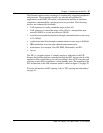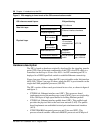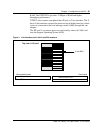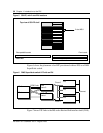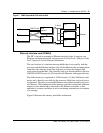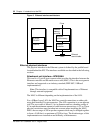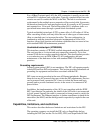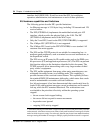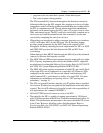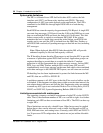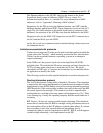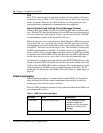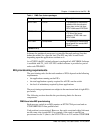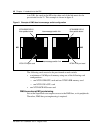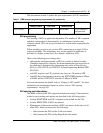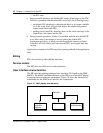
Chapter 1: Introduction to the EIU 35
DMS-100 Family EIU User Guide TELECOM12
— programs were not aware that a period of time had elapsed
— The router stopped routing packets.
The EIU remained fully functional throughout the broadcast storm test.
Although traffic from the EIU stopped, this stoppage was due to all other
components on the LAN being nonfunctional and there was nothing left for
the EIU to communicate with. The test demonstrated that maintenance
personnel could remote login to the EIU, start a CI process, look at some
OMs, and remote logout. The EIU could also successfully complete an in-
service test and could be manual busied, then returned to service after
successfully completing the out-of-service test.
• IP throttling was introduced to address customer concerns on co-residency
of EIUs with other ASUs in an LPP frame. The IP throttling feature
provides partial protection for the DS30 links at the expense of EIU
throughput. Similarly, throttling has been implemented for EIUs on FLIS
and SNSE LIS to protect the links between the MS and EIU from
overloading.
When deployed, fiber SR128 links through the MS will provide enhanced
capacity to alleviate link capacity overload.
• The SNSE LIS and LPP have been product integrity tested with up to eight
EIUs. Capacity engineering rules restrict the number of EIUs supported
per platform to less than eight. Refer to Provisioning Rules for LPP, SSLPP,
and SNSE LIS, System Engineering Bulletin SEB 92-02-001.
• The DMS-100 switch supports a maximum of eight EIUs per switch. Each
of the eight EIUs can be configured on a separate LAN. However, EIUs
configured on the same LAN can provide simple load balancing of IP
traffic between EIUs, and tolerance to failure of a single EIU. For more
information on redundancy and sparing, refer to “EIU sparing and
redundancy” on page 41.
• The EIU can screen IP packets whereby only IP packets from a specified
list of source IP address are accepted into the SuperNode switch and others
rejected. This list of IP addresses is bound in by and is the responsibility of
user applications (for example, EXNDINV).
• OSI and TCP/IP protocols cannot co-exist on the EIU.
• Theoretically, the EIU is capable of routing approximately 350 kbyte/s
with 1536 kbyte packets at the IP level. That measurement equals about 2.5
Mbit/s. This performance measurement is the rate at which the EIU routes
to the F-bus. However, throttling values limit throughput. Refer to
Provisioning Rules for LPP, SSLPP, and SNSE LIS, System Engineering
Bulletin SEB 92-02-001.



